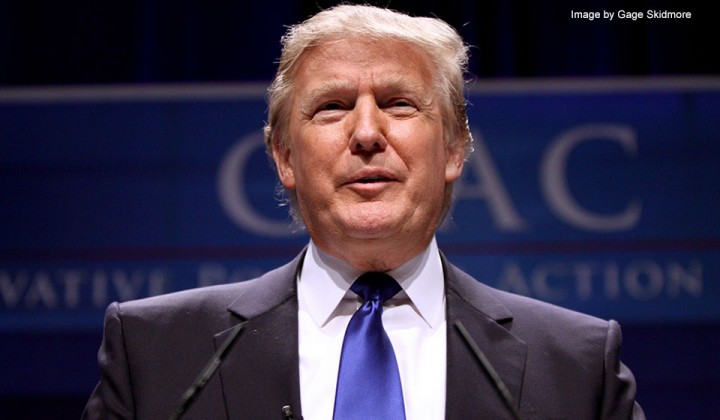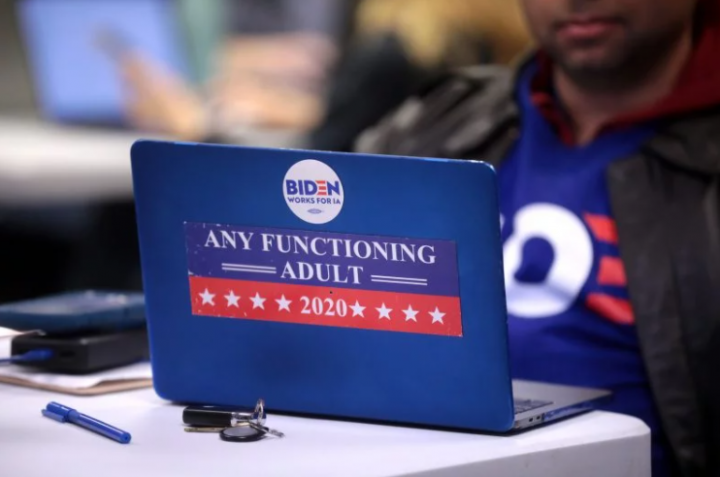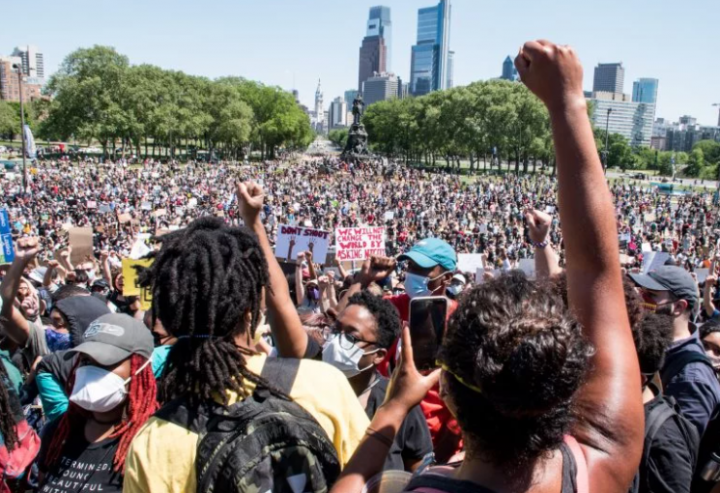Joe Biden was sworn in as US president surrounded by armed troops, in the middle of a pandemic, weeks after a far-right mob stormed the Capitol building. These are unprecedented times. The capitalists are pinning their hopes on the new administration to pull US capitalism out of this period of chaos and decline, but the writing is on the wall.
The swearing-in of the 46th President of the United States was not marked by the typical pomp and circumstance of previous inaugurations. For days, the militarized downtown district of Washington, DC has been described as a “besieged fortress,” patrolled by 25,000 National Guard troops. Soldiers have set up security checkpoints throughout the city and hundreds of troops have been quartered in the halls of the Capitol building itself. The scenes have prompted comparisons with Lincoln’s disguised entry into the capital on the eve of the Civil War, or FDR’s subdued inaugural ceremony, held in the throes of the Great Depression.
During the final week of Trump’s term, the White House correspondent for the New York Times expressed the outlook of the Washington establishment as it watched their “shining city upon a hill” become a symbol of violent polarization and decline, leaving the “reputation of the United States on the world stage at a low ebb”:
"The country has fractured deeply and lost a sense of itself. Notions of truth and reality have been atomized. Faith in the system has eroded. Anger is the one common ground. Historians have struggled to define this moment … the historical moment when we were a model is basically over."

Joe Biden is now officially the president and has announced big plans for his first hundred days in office. The Democrats seek to turn the clock back to the “good old days” under Obama and will enjoy a political trifecta—control of the White House and both houses of Congress. They will have no excuses for not passing laws supported by a majority of Americans. But although the new administration will have a very different style than Trump’s, make no mistake: this remains a government of, by, and for big business. Millions may be breathing a collective sigh of relief but let’s not forget that the “good old days” were also days of exploitation, oppression, mass deportations, immiseration, and malaise—which paved the way for Trump’s rise to power in the first place.
So although a drop of water can come as a relief in a desert, workers shouldn’t expect anything more than a handful of limited “reforms” to take the edge off the most serious crisis ever faced by American capitalism. Like FDR before him, Biden’s task is to try to save the system from itself—with support from the labor leaders and reformists of all stripes.
The final stage of the 2020 election ended with the US Senate runoff in Georgia on January 5. The Democrats won both seats and now have effective control over the Senate. In a Senate that is divided 50/50, Vice President Harris, as President of the Senate, can break all ties in favor of her party. The filibuster is a Senate rule that requires a supermajority of 60 for the body to end debate and move to a vote. It grants the minority de facto veto power over the majority and is often used as a convenient excuse not to move legislation forward. But since changes to the Senate rules can be made by a simple majority, the Democrats could move at any time to eliminate this archaic and undemocratic rule.
The hallmark of American capitalist class rule has been the two-party system. In a country where the richest 1% own 40% of the country’s wealth, while the poorest 90% own only 23%, the ruling class wants to ensure the maintenance of their system of private ownership of the means of production. They have long facilitated their dominance by giving people the illusion of a “choice” between two parties that may vary superficially, but which ultimately represent the capitalists’ fundamental interests. Like the choice between Pepsi and Coke, nobody is allowed to ask whether we should consume cola to begin with. And in politics, nobody should question why the working class has no party of its own.
The bourgeoisie writes the laws and rules, so they naturally make it difficult for new parties to get on the ballot. When upstarts do overcome those hurdles, the rules make it difficult to win positions and to maintain ballot status. But more importantly, the ruling class has used the carrot and stick to keep the labor leaders firmly in line and to marginalize the left—although many on the left have played into their hands by adopting opportunist or sectarian policies.
For decades, the ping-pong between Republicans and Democrats worked wonders for the capitalists, as they firmly controlled both parties. But the “best-laid schemes of mice and men” have been upset in recent years. Dialectics explains that things turn into their opposite, and this applies also to the “most stable capitalist democracy in the world.”
The crisis of the system has played out in a country without a mass workers’ party. Like nature, politics abhors a vacuum, and the pressures of the class struggle must find an outlet in some form or another. The divisions in the ruling class and widespread political confusion have led to deep rifts in both major parties. The Republican Party was taken over by Trump and the far-right wing of the bourgeois and petty bourgeois, backed by millions of angry workers fed up with the liberal status quo. With Trump booted from office and hounded by controversy—not to mention a second impeachment for “inciting insurrection”—a vicious internal war has again erupted in the Republican Party and there could actually be a split in the not-too-distant future.
 With Trump booted from office and hounded by controversy, a vicious internal war has again erupted in the Republican Party / Image: Gage Skidmore, Flickr
With Trump booted from office and hounded by controversy, a vicious internal war has again erupted in the Republican Party / Image: Gage Skidmore, Flickr
With Trump out of office and standing trial as a former president, the real aim of the impeachment campaign is evident: to bar him from holding federal office in the future, in the hopes of cutting across another run in 2024. Senate Republican leader Mitch McConnell apparently sees an opportunity to purge his party of Trumpism, though it remains to be seen whether the required two-thirds Senate majority will come together. What is clear is that this kind of maneuver will not eliminate the growing polarization in society, and does nothing to serve the interests of the working class. With tens of millions still convinced that the elections were illegitimate, the Republican ranks are not about to return quietly to the pre-Trump status quo, even if it means moving toward a Trumpism without The Donald on the ticket, or moving outside the Republican Party altogether.
The Democrats are also divided, but now that they are in power, they will likely be able to keep their elected officials in line. The “left wing” of the party, including the “Squad,” has snapped to order and is playing the role of propping up the Democratic establishment from the left. As an example, consider the fact that the entire Squad, including its new members, voted to elect Nancy Pelosi as Speaker of the House. Pelosi won with few votes to spare. The few Democrats who voted against her were from the right wing of the party. With power comes patronage: “grants” for the states and congressional districts, positions, and “favors” that can bind together those in the governing party. A prime example of this is Bernie Sanders’s elevation to chairman of the powerful Senate Budget Committee.
Money and the Democrats
Despite the temporary boost Trump provided the Republicans, the Democrats remain the top capitalist party on a national basis. They “manage the affairs of the ruling class” in states like California, New York, Illinois, and Massachusetts, and they now control the vast resources and apparatus of the federal government.
In every important election, big business and the rich give money to both parties so they can call in favors no matter who wins. In 2020, more money went to the Democrats than to the incumbent. Michael Bloomberg alone spent $100 million of his own fortune in Florida in a failed attempt to defeat Trump there. The serious bourgeois wanted someone more reliable than the “very stable genius” squatting in the White House. As reported by Jim Zarroli on NPR:
"Of nearly $800 million donated to politicians by securities firms, banks, real estate companies, and their employees by June 30, slightly more than half went to Democrats. That hardly ever happens. While Wall Street went big for Barack Obama in 2008, it switched back to the GOP following the passage of the Dodd-Frank financial overhaul bill and has been reliably Republican ever since."
And according to Bloomberg:
"Wall Street donors gave more money to President-elect Joe Biden than to President Donald Trump … Overall, contributions to House and Senate Democratic candidates, at around $68 million, exceeded contributions to Republicans, at about $55 million, but in both chambers, the real winners were incumbents. Nearly three-quarters of the money given by employees of financial firms went to candidates who already held the office."
There is no question that money is a big influence in politics and government. Some on the left argue that there should be government funding of campaigns, that this would take the money out of politics. But this is a utopian fantasy. Even if there was full government funding of campaigns, as long as the parties in government try to manage capitalism, they would still be controlled by the ruling class. It is the system itself that dictates the parameters of acceptable policies and there is not a lot of room to maneuver when capitalism is in decline. The only way out is to break these fetters. What is needed is a workers’ government based on socialist policies.
The need for a working-class alternative
The only thing that brought Biden’s cross-class “coalition” of voters together was their opposition to Trump. This culminated in the president’s second impeachment and his forthcoming Senate trial. But now that Trump is out, the temporary unity of those who voted Democrat for lack of an alternative, and the dyed-in-the-wool liberal defenders of capitalism will start to break down.

Anyone expecting a fundamental change from Biden and the Democrats will be deeply disappointed. While projecting a bold vision in words, a close look reveals that they have been careful not to promise anything not already delivered by previous presidential managers of capitalism.
We should be crystal clear as to what a fundamental reform is. In a society where the labor of the working class, coupled with the world’s natural resources, creates all the wealth, most of this wealth goes to the richest 10%—and especially to those in the top 2%. A real change to this setup would mean significantly higher wages, better benefits, and other social service benefits, funded directly out of the profits, rent, interest, and property that are currently monopolized by the rich.
In the past, when the Democrats did legislate “reforms,” these programs were ultimately paid for by sections of the working class and the middle class. Keynesians and proponents of so-called “Modern Monetary Policy” argue that deficit spending can easily pay for all of this. But in the real world, debt has its limits, and eventually, there will be increases in taxes on workers, cuts in social spending, and inflation.
Biden has proposed a $1.9 trillion package to deal with the pandemic and to try and keep the economy from sinking further into the muck. This is not a reform, but an attempt to keep the capitalist ship from sinking. The stimulus checks and unemployment benefits will certainly help millions of people from going under altogether, but these pittances will not extricate them from the quicksand of life under capitalism. And though this money is purported to help “working families,” almost all of it will merely make a pit stop in individuals’ bank accounts before flowing by the billions into the pockets of the landlords, banks, other creditors, and profiteers. 45 of the top 50 corporations have flourished during the pandemic, raking in hundreds of billions of dollars—while laying off millions of workers.
Workers need to receive their full wages and be allowed to stay at home if they are not in an essential industry. Those forced to work during the pandemic should be provided all necessary safety equipment and paid at least double their previous wages. Back rent, credit card, mortgage, student, and other debt should be wiped out. Universal health care, free at the point of service, should be provided to everyone living in the country. Any company profiting off the misery or deemed “too big to fail” should be nationalized and run in the public interest under democratic workers’ control. You will not find any of these desperately needed measures among Biden’s proposals!
Even if the Democrats pass a federal $15 minimum wage, this would merely be playing catch up with the real needs of workers and their families. Biden has made it crystal clear that he does not intend on providing universal healthcare. Rejoining the Paris Agreement will do little to combat the climate catastrophe, which will require crossing the line of private property. Racism cannot be uprooted or police brutality eliminated in a society where artificial scarcity is used to divide and rule the majority. We can be sure they will not repeal anti-labor laws like Taft-Hartley, as the capitalist class would fight this tooth and nail. And even a modestly higher tax rate on the superrich would make a mere dent in the superprofits generated by these behemoths.
Although there will be a honeymoon of some kind, the ongoing misery and instability will eventually lead to anger at this “new” government. Whether it takes one, four, or even eight years, tens of millions of current supporters will turn against it, joining the tens of millions who are already against it on day one. The real question is: when the workers get fed up with yet another Democratic administration, will there be a mass working-class political alternative to channel the disillusionment and replace both major parties? Or will people turn again to rabid Trumpist demagogy? Or perhaps simply to dejected apolitical demoralization?
Marxists understand the importance of the working class constructing a party now, but this takes mass forces. At this time, no section of the trade union leadership is moving in this direction. Bernie Sanders and the Squad have hitched their wagon firmly to the Democrats. Jacobin magazine and the right wing of DSA have defended this unprincipled class-collaborationist policy. When the Democrats’ true colors are once again revealed for all to see, these forces will not be seen as distinct from the Democrats, but rather as buttresses for the capitalist establishment.
The incredible George Floyd protest movement and the growing interest in socialist ideas show the potential for revolutionary mass politics in this country. We must begin to build now for the future. We must raise our banner high and implacably defend principled class politics, even if it is a modest banner at this stage. As we saw over the course of 2020, when the working class moves, it can turn things around quickly!
What a real socialist could do in Congress
Talk show host and comedian Jimmy Dore recently called on AOC and the Squad to strike a deal with Nancy Pelosi: their votes to reelect her as Speaker of the House, in exchange for a floor vote on “Medicare for All.” Dore did not like the largely uncritical support the Squad provided the Democratic Party leadership. Although he is right to criticize them, we don’t think his “horse-trading” strategy is the way forward.

If there was a genuine socialist congressperson or caucus, they would not vote for any Speaker of the House from a bourgeois party. They would vote against the capitalist politicians and explain that what workers need is a socialist majority and a socialist Speaker. They would use their platform in Congress to mobilize and build the socialist movement and construct a mass working-class socialist party, which could eventually win majority support. They would explain that the future under capitalism is dark, but the working class can extinguish the darkness with a government of its own, which would move beyond capitalist limits and implement genuine socialist policies.
Marxists support the struggle for significant reforms that result from real concessions wrenched from the ruling class. Such reforms only ever come as a byproduct of the struggle of the working class in the workplaces, in the streets, and politically. However, political struggle requires a class-independent expression in the form of a mass party, of, by, and for the working class. As a working-class political movement takes shape and gains momentum, it can force the ruling class to make some concessions, but the life of exploitation and oppression for the working class will only be fundamentally transformed with the end of the capitalist system.
The key task confronting the broader left and the labor movement is to work towards laying the foundations for just such an independent class party. No one should have any illusions that the tiny, fractured, and currently politically insignificant left can somehow “pressure” Biden into doing anything that seriously challenges capitalism. As we have seen, the Democrats’ entire raison d’être is precisely the opposite. The role of socialists is not to prop up the system but to help accelerate its downfall.
If the DSA called on its elected members and others running for office to do this as independents instead of as Democrats, this would be an important step in the direction of independent class politics. Recently, the Phoenix Chapter of DSA debated this and there was significant support for this approach.
Capitalism has exhausted its historically progressive potential and entered an epoch of instability and decline. Although this will not unfold in a straight line and there can be temporary periods of revival, the writing is on the wall. If you believe a fundamentally different future is possible and want to help the overwhelming majority of society clearly see their class interests and the revolutionary way forward, we invite you to contact the IMT and work with us on this important historic task.



